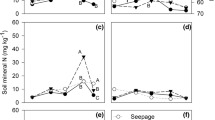Abstract.
Farmers are applying very high amounts of N fertilizer (sometimes >900 kg N/ha), commonly (NH4)2SO4, to irrigated potato (Solanum tuberosum, L.) grown on sandy textured soils in the Cappadocia region of Turkey. To obtain information on potato yield, N uptake, N fertilizer residue in the soil and the portion of N fertilizer leached below 200 cm soil depth, nine field experiments were conducted at three different locations in 1992, 1993 and 1994. The N rates used in these experiments were 0, 200, 400, 600, 800 and 1,000 kg N/ha within a completely randomized block design with three replicates. N fertilizer was applied in two equal portions; one at planting and one just before the first irrigation. Although all yield data were used to find out the marketable tuber yield, the N rate response curve and the fate of applied fertilizer N was determined only for the 400 and 1,000 kg N/ha rates. Isotope microplots were established where 15N-labelled (NH4)2SO4 was applied at 5.0 atom % and 2.5 atom % excess enrichments for the 400 kg N/ha and 1,000 kg N/ha rates, respectively. At harvest, marketable and dry tuber yield was determined for all N rates. Dry tuber and leaf plus vine yields were determined for the isotope microplots and they were analysed for the % N and 15N atom % excess. The % N derived from fertilizer and N use efficiency (%NUE) were calculated for the plant samples. The 15N-labelled residue left in 0–200 cm soil was also determined. The amount of N fertilizer leached below 200 cm soil depth was also calculated. 15N-labelled NO3 – and total NO3 – of the groundwater from wells were determined at different dates. Our results show that the optimum marketable tuber yield was obtained with 600 kg N/ha. Tuber N uptake was increased slightly, while leaf plus vine N uptake increased considerably when the N rate was increased from 400 to 1,000 kg N/ha. The %NUE values decreased nearly by half and the amount of N fertilizer in the 0–200 cm soil layer increased more than 3 times when the N rate was increased from 400 to 1,000 kg N/ha. Nearly half of the applied fertilizer N (45.6%) at 400 kg N/ha and more than half of the applied fertilizer N (60.8%) at 1,000 kg N/ha was still in the 0–200 cm soil layer after harvest. Four times more N fertilizer was leached below 200 cm soil depth when 1,000 kg N/ha N was applied instead of 400 kg N/ha. Our results also indicate that there is a potential contamination of groundwater due to leaching of the applied N fertilizer.
Similar content being viewed by others
Author information
Authors and Affiliations
Additional information
Electronic Publication
Rights and permissions
About this article
Cite this article
Halitligil, .M., Akin, .A. & Ýlbeyi, .A. Nitrogen balance of nitrogen-15 applied as ammonium sulphate to irrigated potatoes in sandy textured soils. Biol Fertil Soils 35, 369–378 (2002). https://doi.org/10.1007/s00374-002-0482-4
Received:
Accepted:
Issue Date:
DOI: https://doi.org/10.1007/s00374-002-0482-4




